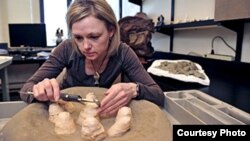The theory that dinosaurs and birds share an evolutionary link just got stronger as scientists have discovered that a bird-like dinosaur may have incubated its eggs much like a brooding chicken.
The study done by researchers at the University of Calgary and Montana State University examined fossilized groups of eggs from a small, meat-eating dinosaur called Troodon. The eggs were found in Alberta, Canada and Montana.
Due to the scarce amount of evidence, paleontologists have long searched for answers about how dinosaurs hatched their young. Crocodiles, a close relative of dinosaurs, bury their eggs in nesting material, usually sand or dirt, while birds lay their eggs in the open or non-covered nests.
The Troodon appears to have laid its eggs vertically, with only the bottoms of the eggs buried in mud, concluded researchers in a finding that was published in the spring issue of Paleobiology.
“Based on our calculations, the eggshells of Troodon were very similar to those of brooding birds, which tells us that this dinosaur did not completely bury its eggs in nesting materials like crocodiles do,” says study co-author Darla Zelenitsky, assistant professor of geoscience at the University of Calgary.
Researcher David Varricchio of Montana State University added that the eggs studied indicated only a “partial burial,” meaning “an adult would have directly contacted the exposed parts of the eggs during incubation.”
The bird-like Troodon lived in North America 77 million years ago.
A key to the finding was comparing the number of pores in the Troodon’s eggs to those of crocodiles and other birds that completely bury their eggs. Pores allow for respiration, and crocodile eggs have more pores than those of a brooding bird. In the case of the Troodon eggs, there were relatively fewer pores indicating the eggs may not have been completely buried.
“For now, this particular study helps substantiate that some bird-like nesting behaviors evolved in meat-eating dinosaurs prior to the origin of birds. It also adds to the growing body of evidence that shows a close evolutionary relationship between birds and dinosaurs,” Zelenitsky says.
The study in Paleobiology is available here.
The study done by researchers at the University of Calgary and Montana State University examined fossilized groups of eggs from a small, meat-eating dinosaur called Troodon. The eggs were found in Alberta, Canada and Montana.
Due to the scarce amount of evidence, paleontologists have long searched for answers about how dinosaurs hatched their young. Crocodiles, a close relative of dinosaurs, bury their eggs in nesting material, usually sand or dirt, while birds lay their eggs in the open or non-covered nests.
The Troodon appears to have laid its eggs vertically, with only the bottoms of the eggs buried in mud, concluded researchers in a finding that was published in the spring issue of Paleobiology.
“Based on our calculations, the eggshells of Troodon were very similar to those of brooding birds, which tells us that this dinosaur did not completely bury its eggs in nesting materials like crocodiles do,” says study co-author Darla Zelenitsky, assistant professor of geoscience at the University of Calgary.
Researcher David Varricchio of Montana State University added that the eggs studied indicated only a “partial burial,” meaning “an adult would have directly contacted the exposed parts of the eggs during incubation.”
The bird-like Troodon lived in North America 77 million years ago.
A key to the finding was comparing the number of pores in the Troodon’s eggs to those of crocodiles and other birds that completely bury their eggs. Pores allow for respiration, and crocodile eggs have more pores than those of a brooding bird. In the case of the Troodon eggs, there were relatively fewer pores indicating the eggs may not have been completely buried.
“For now, this particular study helps substantiate that some bird-like nesting behaviors evolved in meat-eating dinosaurs prior to the origin of birds. It also adds to the growing body of evidence that shows a close evolutionary relationship between birds and dinosaurs,” Zelenitsky says.
The study in Paleobiology is available here.













